Next week, the Virginia Board of Education will consider changes to how schools across the state are scored and measured as effective — part of Gov. Glenn Youngkin’s push to raise standards and increase transparency about student test scores.
The current Standards of Accreditation is a complex system that takes multiple variables — including academic achievement, as well as college and career readiness — into account. The criteria are formally called school quality indicators, and schools earn different accreditation ratings based on how well they perform on these nine indicators.
Last month, board members discussed a temporary pause on the use of chronic absenteeism as an indicator. Meanwhile, officials in the Youngkin administration proposed adding two new indicators: annual student pass rates for reading and math.
Amy Siepka, director of the Virginia Department of Education’s Office of Accountability, told board members in March that there’s concern about the way current indicators measuring student achievement are presented to the public. That’s because information reported on publicly-facing school dashboards clumps together data about students who pass standardized tests with those who don’t pass, but show growth.
She pointed to one school with a “combined rate” of 82% – meaning 82% of students either passed that grade-level test or showed growth compared to the prior year’s test results. However, despite that school only having a 40% pass rate, it was rated at the same level — the highest of the three available — as another school that had a 93% pass rate.
“For some schools … it masks the student performance level,” Siepka told board members. “That [82%] doesn’t have the appearance that that’s an issue where students or schools need to focus. Certainly, that is an area that that school needs to focus on.”
The department has contracted with Anne Hyslop and Chad Aldeman to work on the draft changes and solicit feedback from other groups.
“Right now, the system is really looking more at growth and not very much at pass rates,” Hyslop told the board in March. “Adding a second indicator would sort of be giving you a ‘proficiency pass rate indicator’ alongside the other more growth-oriented indicator and giving them more equal weight.”
VPM News was not granted interviews with Hyslop or Aldeman by deadline. Hyslop told VPM News via Twitter that the work is just beginning, and it will “be an iterative process with the Board.”
Kim Richey, deputy superintendent for the state Division of School Quality, told board members in March that the outreach to other groups “is an ongoing process, and we certainly plan on casting a very broad net and getting input from as many stakeholders as possible.”
Chad Stewart, policy analyst for the Virginia Education Association, said putting more emphasis on standardized test scores when determining school accreditation could backfire. He said that’s what happened when he was teaching at Henrico County’s Elko Middle School several years ago: The school lost full accreditation, which Stewart said was largely fueled by changing student demographics — with more families living in poverty being priced out of the city and moving into the county.
Suddenly, teachers were saddled with additional paperwork.
“Intuitively, I saw an exodus of all the most experienced teachers from the school because they said, ‘We're not putting up with these hours and hours of additional paperwork we're going to have to fill out for compliance for the state for all this,’” Stewart said.
“These were teachers who were going above and beyond serving students with a lot of needs, volunteering after school, for tutoring and just trying to close gaps and who are very committed to serving students with a lot of needs. But to be asked to go beyond that for paperwork exercises that they see as not meaningful for improving outcomes of their students … I think that was a breaking point.”
Kim Bridges, assistant professor of educational leadership at Virginia Commonwealth University, echoed that there can be severe implications and unintended consequences to major changes to accountability systems, including increased school segregation.
"If you get schools whose ratings change, you often get folks who don't like that label, and might choose to leave that school, and then that sort of sends the school into a spiral,” Bridges said. “We see evidence that rating systems … can drive things like school segregation, and enrollment changes.”
There’s also a push from the Youngkin administration to increase the scores needed to pass to more closely align Virginia’s standards with proficiency scores from the National Assessment of Educational Progress. Experts, however, previously warned against comparing the tests. Both left-leaning and right-leaning research groups point out that states that raised cut stores to align with NAEP standards haven’t seen meaningful increases in test scores.
“We find no correlation at all between a lift in state standards and a rise in student performance, which is the central objective of higher proficiency bars,” states an analysis from right-leaning Education Next of 2017 state proficiency standards. “While higher proficiency standards may still serve to boost academic performance, our evidence suggests that day has not yet arrived.”
Virginia’s cut scores — which determine what is considered a proficient score — were lowered for multiple grade-level tests under former Republican Gov. Bob McDonnell. Although, according to a historical memo presented to board members, that’s because the overall rigor of the tests themselves was raised.
VPM News has submitted a public records request for different iterations of select tests over the last decade to see what has changed. Meanwhile, work is underway to revise the current exams — but it’s unclear if the timeline and work involved in revising the tests’ content and changing cut scores will align.
Bridges was part of a separate accountability-focused workgroup last year, but said she’s unsure if and how feedback from that group will be incorporated into the state’s current work.
“The big thing that concerns me about this is that that group was very clear on continuing to balance both this idea of proficiency and growth,” Bridges said. “Adjusting the balance of those two things, at this point, should be of concern to folks who want to make sure that they're getting credit for the good teaching that they're doing that might be bringing students along post-pandemic.”
Rodney Jordan, a Norfolk School Board member who was on the same workgroup as Bridges, hopes the group’s recommendations are taken into consideration as part of the state accountability system overhaul.
He added, however, that he’s not sure if those recommendations have been incorporated into a formal report yet, which was due to lawmakers in November. When he reached out to the Virginia Department of Education in January to ask if a report was available, he was told there was no update.
“I truly want my role and my input to be about students and not adult politics,” Jordan said.



